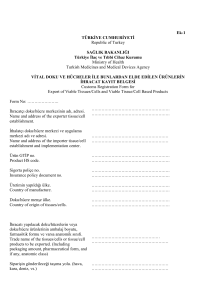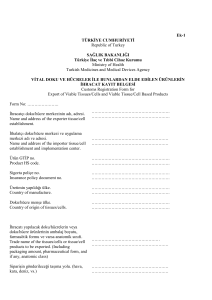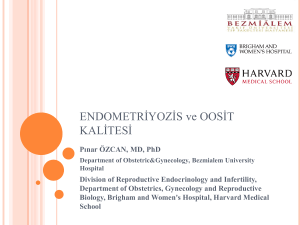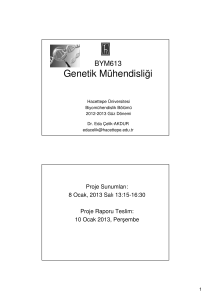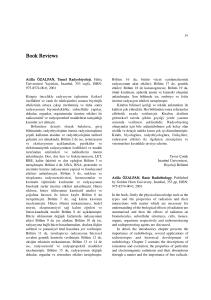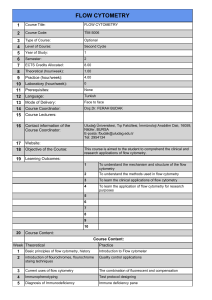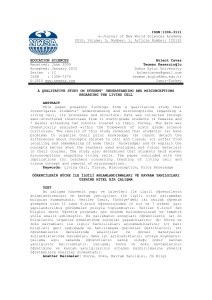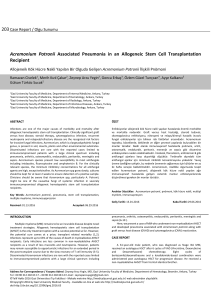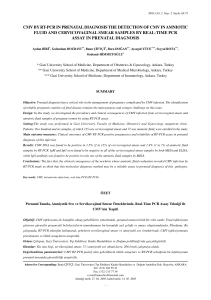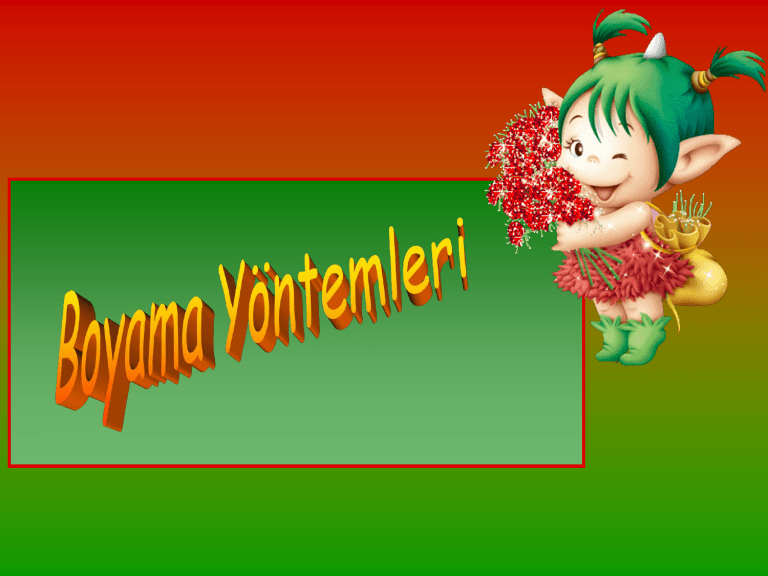
Neden bakterileri
boyamalıyız?
Bacteria have nearly the same refractive index as
water, therefore, when they are observed under a
microscope they are opaque or nearly invisible to the
naked eye.
Different types of staining methods are used to make
the cells and their internal structures more visible
under the light microscope.
.
2
Bakteriler transparan, mikroskop altında
görülmesi zor
Boyama ile:
Hücre büyüklüğü, şekli, hücrelerin yerleşimi,
Gram boyanma özelliği, kapsül varlığı, endospor
varlığı incelenebilir
Basit boyama
Gram boyama
Aside dirençli boyama
Kapsül boyası
Spor boyası
Stains:
Increases the contrast by binding
selectively to certain cell or certain parts of
cells making them readily visible
• Bacteria are slightly
negatively charged at
pH 7.0
– Basic dye stains bacteria
– Acidic dye stains
background
• Simple stain
– Aqueous or alcohol
solution of single basic
dye
5
Bazik pozitif yüklü, bakteriler
negatif yüklü
Asidik negatif yüklü
Mordant hücrelerin boyaya olan
afinitesini arttırır
Bazik boyalar
Safranin
Bazik fuksin
Kristal viyole
Metilen mavisi
Asidik boyalar
Eozin
Asid fuksin
Kongo kırmızısı
Boyalar
• Pozitif ya da negatif yüklü organik tuzlardır
• Bir iyon renklidir: Kromofor (chromophore)
• Bazik boya: Pozitif iyon renklidir
Metilen Mavisi+ Cl• Asidik boya: Negatif iyon kromofordur
Bazik boyalar
Kromofor grubu pozitif yüke sahiptir.
Bu tür boyalara katyonik boyalar da denir.
Örnek:
Metilen mavisi bazik bir boyadır.
İçeriği:tetramethhyl-thionin-chlorhydrate’tır.
Tetramethyl-thionin baz’ı hidroklorik asit ile nötr bir tuz
meydana getirecek şekilde birleşmiştir.
Tetramethyl-thionin bazı renklidir ve metilen mavisi boyasına
rengini verir, anyon kökü olan hidroklorik asit ise renksizdir
Bakterilerin yüzeyi negatif olduğu için ayrıca DNA’da bulunan
fosfatların da negatif yüklü olması nedeniyle katyonik
özelliğe sahip olan bazik boyalarla boyanırlar.
Asidik boyalar
Boyayıcı kısımları negatif elektriksel yüke sahiptir.
Bu tür boyalara anyonik boyalar da denir.
Asitik boyalar zemini boyamak için kullanılmaktadır.
Asit fuksin, anilin blue, kongo red, çini mürekkebi, nigrosin,
malaşit yeşili …
1.
2.
Basit boyama bazik boya
Ayırt edici boyama M.o.ları birbirinden
ayırt edilmesini sağlar
primer boya dekolorize zıt boya
3.
Özel boyama yöntemleri
Leifson – flajel boyama
Negatif - kapsül boyama
Boyama için;
1. Preparat hazırlanır:
İncelenecek örnek temiz kuru bir lam üzerine yayılır. Yayma için
öze, lam veya lamel kullanılır. Daha sonra lam havada kurutulur.
2. Fiksasyon yapılır:
Amaç, lam üzerinde kurumuş olan bakterilerin lama yapışmasını
sağlamaktır. Böylece boyama esnasında akıp gitmezler.
fiziksel fiksasyon (tespit): yüzey üstte kalacak şekilde 2-3 kere
bek alevden geçirilir.
kimyasal fiksasyon (tespit): metil alkolde 3 dk bekletilir,
kurutulur.
3. Boyama yapılır.
Yaymanın hazırlanması
Dr.T.V.Rao MD
13
Tespit edilmesi
(fixation)
AMAÇ:
Hücrelerin şeklinin
korunmasını sağlamak
Sometimes heat fixation is
used to kill, adhere, and
alter the specimen so it
will accept stains
14
Isı ile tespit etme (Heat fixing)
•
•
•
Bakteriyi lama fikse eder
Canlı olabilecek mo’ları öldürür
Hücre membranı ve duvarının boyaya
daha geçirgen hale gelmesini sağlar
Basit boyama
• simplest, the actual
staining process may
involve immersing the
sample (before or after
fixation and mounting)
in dye solution, followed
by rinsing and
observation.
• The stain can be poured
drop by drop on the
slide
16
Basit boyama
• Methylene blue, Basic fuchsin
• Provide the color contrast but impart the same color
to all the organisms in a smear
• Loffler's methylene blue: Sat. solution of M. blue in
alcohol - 30mlKoH, 0.01% in water -100mlDissolve the
dye in water, filter. For smear: stain for 3’.
17
Simple Staining Easier to
Perform
But has Limitations
• Simple easy to use;
single staining agent
used; using basic and
acid dyes.
• Features of dyes: give
coloring of
microorganisms; bind
specifically to various
cell structures
18
Ayırt edici boyalar
Differential Stains use two or more stains
and allow the cells to be categorized into
various groups or types.
Both techniques allow the observation of
cell morphology, or shape, but differential
staining usually provides more information
about the characteristics of the cell wall
(Thickness).
19
Gram staining
Hans Christian Joachim Gram (September 13, 1853 - November 14, 1938)
In Berlin, in 1884, he developed a method for distinguishing between two major
classes of bacteria.
• Named after Hans
Christian Gram,
differentiates between
Gram-positive purple
and Gram-negative pink
stains and is used to
identify certain
pathogens.
20
1880: Christian Gram
1880: Christian Gram
Gram – and + Cell Walls
Bakteri hücre yapısı:
a)- Gram pozitif bakterilerin hücre çeperinde Gram negatiflere
kıyasla oldukça kalın peptidoglikan tabaka mevcuttur. Bu nedenle
aldıkları boyayı alkolle dekolarizasyonda gram negatiflere nazaran
daha geç bırakırlar.
b)- Gram pozitif bakterilerin hücre çeperinde karbonhidratlar, gram
negatiflerde lipidler fazladır. Karbonhidratlar alkolle dekolarizasyon
esnasında dehidratasyona (su molekülü açığa çıkar) uğrar. Porlar iyice
büzüşür , daralır ve boya dışarı çıkamaz. Lipitler için ise alkol
çözücüdür ve hücre çeperinde olan porlar daha çok açılacaktır.
c)- Gram pozitif hücre çeperinde bulunan teikoik asit, bazik
boyalarla daha kuvvetli birleşik oluşmasını sağlar.
Gram Staining Steps
1.
Crystal violet :primary stain. Crystal violet may also be used as a simple
stain because it dyes the cell wall of any bacteria.
2. Gram’s iodine acts as a mordant (Helps to fix the primary dye to the
cell wall).
A mordant is a substance used to set dyes on fabrics by forming an insoluble
compound with the dye.
Crystal violet (CV) dissociates in aqueous solutions into CV+ and chloride (Cl – )
ions. These ions penetrate through the cell wall and cell membrane of both
Gram (+) and Gram(-) cells. The CV+ ion interacts with negatively charged
components of bacterial cells and stains the cells purple. Iodine (I – or I3 – )
interacts with CV+ and forms large complexes of crystal violet and iodine (CV
– I) within the inner and outer layers of the cell.
3. Decolorizer is used next to remove the primary stain (crystal violet)
from Gram(-) bacteria (those with LPS imbedded in their cell walls).
Decolorizer is composed of an organic solvent, such as, acetone or
ethanol or a combination of both.)
4. A counter stain (Safranin), is applied to stain those cells (Gram
Negative) that have lost the primary stain as a result of decolorization
25
Differential Stain: The Gram Stain
Gram Boyama Yönteminin Yararları
1- Mikroorganizmaları gram pozitif ve gram negatif diye
iki ana gruba ayırır.
2- Mikroorganizmaların morfolojisi ve dizilimi esas
alınarak ön tanı konur. Buna dayanarak nisbeten uygun
bir antibiyotik seçilir, izolasyon için uygun besiyeri
seçimi yapılır.
3- Örneğin usulüne uygun olup olmadığı hakkında bilgi
verir.
1
2
3
4
5
6
Gram Stain
Gram pozitif
Gram negatif
Winn’s Law
•
•
•
•
•
•
All gram-positive organisms aren’t blue
All gram-negative organisms aren’t red
All cocci aren’t round
All bacilli aren’t long
Bonus: Some bacteria stain poorly
Super Bonus: Some bacteria don’t stain
at all
Finally, a counterstain of basic fuchsin is applied to the smear
to give decolorized gram-negative bacteria a pink color.
Some laboratories use safranin as a counterstain instead.
Basic fuchsin stains many Gram-negative bacteria more
intensely than does safranin, making them easier to see.
Some bacteria which are poorly stained by safranin, such as
Haemophilus spp., Legionella spp., and some anaerobic bacteria,
are readily stained by basic fuchsin, but not safranin.
Acid-Fast Stain
• Acid-fast cells contain a
large amount of lipids and
waxes in their cell walls
– primarily mycolic
acid
• Acid fast bacteria are
usually members of the
genus Mycobacterium or
Nocardia
– Therefore, this stain is
important to identify
Mycobacterium or
Nocardia
39
Aside dirençli hücre duvarı
Ziehl-Neelsen stain
• Ziehl-Neelsen staining is used to stain
species of Mycobacterium tuberculosis
that do not stain with the standard
laboratory staining procedures like
Gram staining.
• The stains used are the red colored
Carbol fuchsin that stains the bacteria
and a counter stain like Methylene blue
or Malachite green.
41
Ziehl- Neelsen Procedure
1. Make a smear. Air Dry. Heat Fix.
2. Flood smear with Carbol Fuchsin stain
– Carbol Fuchsin is a lipid soluble, phenolic compound, which is
able to penetrate the cell wall
3. Cover flooded smear with filter paper
4. Steam for 10 minutes. Add more Carbol Fuchsin stain
as needed
5. Cool slide
6. Rinse with DI water
7. Flood slide with acid alcohol (leave 15 seconds). The
acid alcohol contains 3% HCl and 95% ethanol,
or you can declorase with 20% H2 S04
– The waxy cell wall then prevents the stain from being
removed by the acid alcohol (decolorizer) once it has
penetrated the cell wall. The acid alcohol decolorizer will
remove the stain from all other cells.
42
Ziehl- Neelsen
8. Tilt slide 45 degrees over the sink and add
acid alcohol drop wise (drop by drop) until the
red color stops streaming from the smear
9. Rinse with DI water
10. Add Loeffler’s Methylene Blue stain
(counter stain). This stain adds blue color to
non-acid fast cells!! Leave Loeffler’s Blue
stain on smear for 1 minute
11. Rinse slide. Blot dry.
12. Use oil immersion objective to view.
43
1
3
6
4
2
5
7
Ziehl-Neelsen
stain
44
Aside dirençli boyama
Acid Fast Stain
• Mycobacterium
smegmatis (pink)
acid fast retain the
carbolfuchsin dye
• Micrococcus luteus
(blue) not acid fast
decolorized with
acid-alcohol
conterstained with
methylen blue
http://www.bact.wisc.edu/Microtextbook/images/book_3/chapter_3/3-17.jpg
Acid Fast Stain
Mycobacteria
Kapsül boyası
Flajel boyası
Tannik asit tuzları
Flajel boyası
Spor boyası
Malaşit yeşili
Endospore staining
(Schaeffer-fulton Method)
• Spore: green
• Vegetative cell: red
• Preparation of a Bacterial Smear-Air dry
• Application of Primary Dye (Malachite
Green) w/ concurrent application of heat
• Allow slide to cool
• Rinse w/ water
• Application of Counterstain (Safranin)
http://www.arches.uga.edu/~howie/MVC-052endoS.JPG
http://homepages.wmich.edu/~rossbach/bios312/LabProcedures/endospore.jpg
Endospore staining
(Schaeffer-fulton Method)
• Prepare a smear of the bacteria Bacillus
megatatium (a spore-producing organism)
• Flood the smear with malachite green
• Do not allow the stain to evaporate or
completely evaporate.
Endospore staining…
• Remove from heat and allow slides to cool
• Once the slides are cool (important) rinse
with water
• Flood the sample with safranin (30-60
seconds)
• Rinse the slide blot dry observe under
microscopy. 10x, 40x, 100x (oil immersion).
http://www.tgw1916.net/video_pages/Spore.html
http://www.answers.com/topic/endospore
PRESUMPTIVE IDENTIFICATION OF STAPHYLOCOCCI
Gram positive cocci in clusters provide a presumptive identification of
staphylococci. One cannot distinguish coagulase-positive from coagulasenegative staphylococci;the anaerobic staphylococci (peptococci) have a similar
appearance. If well-defined clumps of cocci are present in a clinical specimen
and are extracellular, the identification of these organisms as staphylococci is
In this Gram-stained smear of a positive blood culture bottle one can see gram-pos
cocci in pairs, chains (arrows), and clusters (arrowhead). It is often possible to diff
entiate streptococci (chains) from staphylococci (clusters). When they are seen tog
however, it is best to remain non-committal, reporting only gram-positive cocci. Bot
genera may be present, but it is particularly important not to direct attention away
the possible presence of staphylococci by reporting streptococci even if they are t
predominant form, as the staphylococci will not respond to penicillin therapy.
Group B beta hemolytic streptococci were recovered in culture in this case.
Evaluation of the morphology of cocci on smears made from growth on agar
media may be misleading. This smear of a Group B streptococcus taken from
blood agar plate contains gram-positive cocci in pairs and chains, but tetrad
clumps are also present. If the morphology is uncertain, the gram stain reac
and morphology from a four-hour broth culture should be evaluated.
DISTINCTIVE AND CLASSIC MORPHOLOGY OF PNEUMOCOCCUS
(defined as lancet-shaped diplococci)
Some authorities describe a “chain” as more than four cocci in a row, by wh
definition two paris of pneumococci that haven’t separated do not qualify a
“chain.” Of course, there are always exceptions! In this field the number o
in some chains “squeaks” over the arbitrary limit of the definition. Notice
one of the cocci is more elongated (“a bigger lance”) than others (arrow).
FILAMENTOUS GRAM POSITIVE BACILLI
In addition, the filamentous gram positive bacilli, of which
Actinomyces sp and Nocardia sp. are the most important
members, may fragment and resemble gram-positive coccobacilli.
LARGE PLUMP GRAM-POSITIVE BACILLI
Large plump gram-positive bacilli suggest the identification of either
Clostri-dium sp or Bacillus sp., although some lactobacilli may be
rather broad. The clinical situation often helps to provide a
presumptive diagnosis. The clostri-dial species that most
characteristically has this morphology is the most important
pathogen, Clostridium perfringens (shown here).
SPUTUM SMEAR FROM A PATIENT
WITH A MENINGOCOCCAL PNEUMONIA


